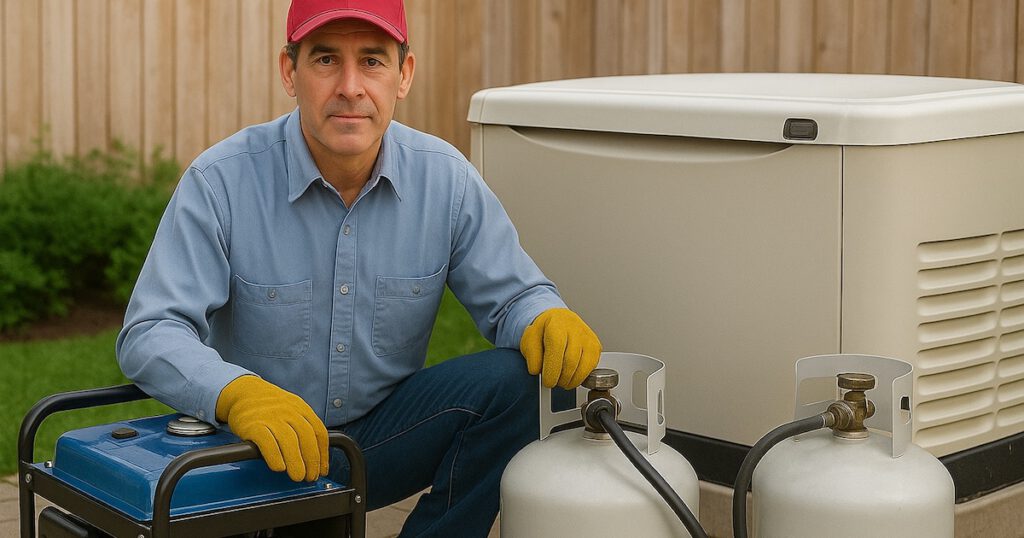
Choosing between portable and standby propane generators depends on your power needs, budget, and preparedness goals for maintaining essential electricity during outages.
This comprehensive guide compares both generator types, helping you understand their capabilities, costs, and installation requirements to make the best choice for your home or business power backup needs.
Understanding Propane Generator Types
Propane generators convert propane gas into electrical power through internal combustion engines, providing reliable backup electricity during outages. The two main categories — portable and standby — serve different purposes and user requirements.
Portable Propane Generators
Best for: Temporary power needs, camping, construction sites, and emergency backup
Portable generators are wheeled units that can be moved to different locations as needed. They typically range from 2,000 to 12,000 watts and are designed for intermittent use rather than continuous operation.
- Mobility — Easy to transport and position where needed
- Versatility — Can power various locations and applications
- Lower upfront cost — More affordable initial investment
- Manual operation — Requires user intervention to start and monitor
Standby Propane Generators
Best for: Whole-house backup, critical systems protection, and automatic operation
Standby generators are permanently installed systems that automatically activate during power outages. They range from 7,000 to over 150,000 watts and provide seamless backup power for essential home systems.
- Automatic operation — Starts automatically when power fails
- Higher power output — Can power entire homes or businesses
- Permanent installation — Professional installation required
- Advanced features — Smart monitoring and remote control capabilities
Power Output and Capacity Comparison
Portable Generator Specifications
Portable units offer flexible power options:
| Power Rating | Typical Use | Runtime (at 50% load) | Key Features |
|---|---|---|---|
| 2,000-4,000W | Small appliances, camping | 8-12 hours | Compact, lightweight, quiet operation |
| 5,000-7,000W | Essential home circuits | 6-10 hours | Multiple outlets, electric start |
| 8,000-12,000W | Whole-house essentials | 4-8 hours | Heavy-duty construction, fuel efficient |
Standby Generator Specifications
Standby systems provide robust power solutions:
| Power Rating | Typical Use | Runtime (at 50% load) | Key Features |
|---|---|---|---|
| 7,000-15,000W | Average home backup | 24-48 hours | Automatic start, whole-house coverage |
| 16,000-25,000W | Large home systems | 24-72 hours | Smart load management, remote monitoring |
| 25,000W+ | Commercial applications | 48-96 hours | Advanced controls, multiple fuel options |
Fuel Efficiency and Consumption
Propane Usage Comparison
Understanding fuel consumption helps calculate operating costs:
Portable Generators
- Small units (2,000-4,000W) — 0.5-1 gallon per hour at 50% load
- Medium units (5,000-7,000W) — 1-2 gallons per hour at 50% load
- Large units (8,000-12,000W) — 2-3 gallons per hour at 50% load
- Fuel efficiency — Generally less efficient than standby models
Standby Generators
- 7,000-15,000W units — 1.5-2.5 gallons per hour at 50% load
- 16,000-25,000W units — 2.5-4 gallons per hour at 50% load
- Large commercial units — 4+ gallons per hour at 50% load
- Fuel efficiency — Better efficiency through optimized design
Fuel Storage Considerations
Both types require adequate propane storage:
- Portable generators — Use standard 20-100 lb cylinders
- Standby generators — Connect to residential or bulk tanks
- Storage requirements — Follow local codes and safety regulations
- Fuel availability — Ensure reliable propane supply during outages
Installation and Setup Requirements
Portable Generator Installation
Portable units require minimal installation:
Basic Setup Steps
- Position generator — Place on stable, level surface outdoors
- Ground system — Connect to grounding rod for safety
- Fuel connection — Attach propane cylinder or hose
- Electrical connection — Use appropriate transfer switch or cords
Safety Considerations
- Ventilation — Operate in well-ventilated outdoor areas
- Carbon monoxide — Never operate indoors or near air intakes
- Electrical safety — Use GFCI protection and proper grounding
- Fuel storage — Keep propane cylinders in approved locations
Standby Generator Installation
Standby systems require professional installation:
Installation Process
- Site preparation — Concrete pad and electrical conduit
- Generator placement — Permanent outdoor location with proper clearances
- Fuel line installation — Underground propane line connection
- Electrical integration — Automatic transfer switch installation
Professional Requirements
- Licensed electrician — For electrical connections and transfer switch
- Plumber or propane technician — For fuel line installation
- Local permits — Building and electrical permits required
- Inspection requirements — Local code compliance verification
Cost Comparison and Budget Considerations
Initial Investment Costs
Compare upfront costs for both generator types:
| Generator Type | Unit Cost | Installation Cost | Total Investment |
|---|---|---|---|
| Portable 4,000W | $400-$800 | $100-$200 | $500-$1,000 |
| Portable 8,000W | $800-$1,500 | $200-$400 | $1,000-$1,900 |
| Standby 10,000W | $3,000-$5,000 | $2,000-$4,000 | $5,000-$9,000 |
| Standby 20,000W | $5,000-$8,000 | $3,000-$6,000 | $8,000-$14,000 |
Ongoing Operating Costs
Consider long-term expenses:
Portable Generator Costs
- Fuel costs — Pay per gallon used during operation
- Maintenance — Annual service and oil changes ($100-$200)
- Storage — Weather protection and security
- Replacement parts — Occasional component replacement
Standby Generator Costs
- Maintenance contracts — Annual service agreements ($200-$500)
- Insurance — May affect homeowners insurance rates
- Property taxes — Generator may increase assessed value
- Extended warranties — Optional coverage for major components
Reliability and Automatic Operation
Portable Generator Reliability
Portable units require manual operation:
- Manual start — User must start generator when power fails
- Load management — Manual connection of appliances and circuits
- Monitoring required — Someone must check fuel levels and operation
- Limited runtime — Requires refueling for extended outages
Standby Generator Reliability
Standby systems provide automatic protection:
- Automatic start — Activates within seconds of power failure
- Self-monitoring — Built-in diagnostics and safety systems
- Load shedding — Prioritizes essential circuits automatically
- Extended runtime — Can operate for days with proper fuel supply
Maintenance and Service Requirements
Portable Generator Maintenance
Owner-performed maintenance is typical:
Regular Maintenance Tasks
- Oil changes — Every 50-100 hours of operation
- Air filter cleaning — Monthly or as needed
- Spark plug replacement — Every 200 hours
- Fuel system checks — Before each use
Recommended Service Schedule
- Pre-season inspection — Before heavy use periods
- Mid-season check — After 50 hours of operation
- End-of-season maintenance — Prepare for storage
- Annual professional service — Recommended for reliability
Standby Generator Maintenance
Professional maintenance is essential:
Professional Service Requirements
- Monthly self-checks — Automatic system tests
- Annual professional service — Required maintenance
- Oil and filter changes — Professional service recommended
- System diagnostics — Computerized performance testing
Service Contract Benefits
- Priority service — Faster response during emergencies
- Extended warranty — Coverage beyond manufacturer warranty
- Performance monitoring — Regular system health checks
- Emergency support — 24/7 technical assistance
Noise Levels and Environmental Impact
Noise Comparison
Generator noise affects neighborhood relations:
Portable Generators
- Standard models — 65-75 dB at 23 feet (lawnmower level)
- Inverter models — 50-60 dB (quiet conversation level)
- Location flexibility — Can be positioned away from living areas
- Operation timing — Can run during appropriate hours
Standby Generators
- Standard installations — 60-70 dB at 23 feet
- Quiet models — 55-65 dB with sound attenuation
- Fixed location — Noise affects same area consistently
- Automatic operation — May run during quiet hours
Environmental Considerations
Both types have similar environmental profiles:
- Propane emissions — Clean-burning fuel with low emissions
- Carbon footprint — Lower than gasoline generators
- Energy efficiency — Improved designs reduce fuel consumption
- Recycling programs — Many manufacturers offer take-back programs
Safety Features and Regulations
Safety Standards
All propane generators must meet safety requirements:
UL Certification
- Electrical safety — Proper grounding and GFCI protection
- Carbon monoxide detection — Built-in safety systems
- Overspeed protection — Automatic shutdown features
- Low oil shutdown — Prevents engine damage
EPA Regulations
- Emission standards — Meet federal air quality requirements
- Noise regulations — Local ordinances may apply
- Fuel storage — Propane tank installation requirements
- Installation permits — Local building code compliance
Making the Right Choice
When to Choose Portable Generators
Portable generators work best for:
- Budget-conscious buyers — Lower upfront investment
- Infrequent power needs — Occasional outages or special events
- Mobile requirements — Need power in different locations
- DIY installation — Prefer to handle setup yourself
When to Choose Standby Generators
Standby generators are ideal for:
- Frequent outages — Areas with unreliable power service
- Whole-house protection — Need to power essential systems
- Medical equipment — Critical health and safety needs
- Business continuity — Commercial and operational requirements
Hybrid and Advanced Options
Portable-Standby Hybrids
Some systems offer the best of both worlds:
- Mobile standby units — Can be used portably or installed permanently
- Automatic portable systems — Portable units with auto-start capabilities
- Modular systems — Multiple portable units that work together
- Solar hybrid options — Combine generator with solar power
Smart Technology Features
Modern generators include advanced capabilities:
- Remote monitoring — Smartphone apps for system control
- Load management — Automatic prioritization of essential circuits
- Maintenance alerts — Proactive service reminders
- Performance tracking — Usage and efficiency monitoring
Getting Started with Propane Generators
Assessment and Planning
Proper planning ensures the right generator choice:
- Calculate power needs — Determine essential and total power requirements
- Evaluate budget — Consider initial and long-term costs
- Check local codes — Research permits and installation requirements
- Compare options — Get quotes from multiple suppliers
Professional Consultation
Expert advice improves decision-making:
- Electrical assessment — Professional load calculation
- Site evaluation — Installation feasibility and requirements
- Code compliance — Local regulation expertise
- Product recommendations — Best options for specific needs
Final Considerations
Choosing between portable and standby propane generators depends on your specific power needs, budget, and level of automation required. Portable generators offer flexibility and lower cost for occasional use, while standby systems provide automatic protection for critical power needs.
Consider your typical outage frequency, essential power requirements, and available space when making your decision. Both options provide reliable propane-powered backup electricity when you need it most.
Ready to explore propane generator options? Contact local dealers for personalized recommendations and professional installation services.
Additional Resources
Learn more about propane generators:
- National Fire Protection Association (NFPA) — Generator safety standards
- Generac Corporation — Industry-leading manufacturer resources
- Propane Education & Research Council — Propane generator information
- Electrical Safety Foundation International — Generator installation guidelines
Always consult licensed professionals for generator selection, installation, and maintenance to ensure safety and compliance with local codes.
About Jennifer Whitaker
Propane industry expert and content contributor for MyPropane.com.
View all posts by Jennifer Whitaker →Related Articles

Essential Propane Guide for Food Truck Operators
Nov 5, 2025 • 9 min read
Discover how to manage fuel safely and efficiently to prevent downtime in your mobile food business.

Essential Propane Management for High Use Farms
Nov 18, 2025 • 3 min read
Learn how to manage your farm's high-volume propane supply safely and effectively.